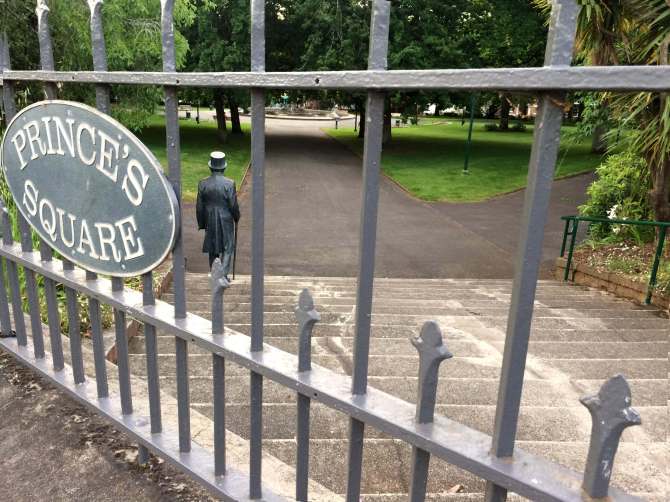As an adult in the 1890s, George Fuller sat down and recalled ‘from memory’ the places, buildings and people of his youth during the 1830s and 40s in Launceston, Tasmania.
With a copy of his written recollections in hand, I take a walk with George along a section of St John Street, discovering – through his eyes – just how much has changed.
As we stroll along the east side, George describes the entire square between Elizabeth and Frederick Streets as being open land. The only building, St John’s Church, stood all alone surrounded by a white picket fence. Today, the original Church is upstaged by its newer, more ornate companion.
Reaching the corner, we’re delighted to discover a row of buildings still standing. George recalls Dr Pugh’s private residence having an adjoining Chemist shop, and that Miss Waddell’s two-storey Lady’s School was located next door.
Continuing on, we take our first steps along the stretch of ‘open land’ from George’s younger years. Far from empty, the first of many intruders appears to stare at us from above.
Further on, the newer residents favour a fresh, classic look. With style and colour-schemes duplicated row upon row and reaching Canning Street, it’s easy to wonder if George would have be impressed by the additions to the then-vacant land.
Crossing the street to the east where orchards once stood, a splash of blue beckons us closer. Tempted to stay, we instead head back – our walk together almost at an end.
As we approach the corner of Frederick Street, George describes what to expect. Looking for the late Mr Wheedon’s place, then a private residence ‘stood back’, we are instead met by a tower of limestone, brick and iron reaching for the sky.
Chalmers Church was built after George’s time in Launceston, and officially opened in 1860. Still standing strong today, the gothic-style and peeling paintwork make it one of St John Street’s most recognisable structures.
Leaving Chalmers, we make our way toward the open land that was – and still is – Prince’s Square. Joining Dr Pugh as he descends the stairs immortalised in bronze, we enter our final destination.
As we make our way toward the fountain, George recalls that the Military would muster here on the Queen’s birthday to go through their drill and fire a salute. No doubt an exciting occasion for a young boy, he even remembered that Colonel Cumberland was in charge of the 96th Regiment.
Stopping to take in our lush surrounds, we silently contemplate where our next walk together through the streets of Launceston may be.
__________________________________________________________________
A walk with George was created as part of The Photo Essay unit through the University of Tasmania. Using 7-10 photos, each with a caption of 1-3 sentences, the idea was to use images and words to tell a story.
‘Recollections of Launceston‘ (1836-1847) is an Indexed Transcription of an unpublished collection of notes and letters dated 1897 by George Samuel Fuller (‘from memory’), transcribed by Margaret Szalay (NSW, 2003) from original material held in the Manuscripts Collection at the Mitchell Library, Sydney, NSW.
The section of St John Street I have photographed (using iPhone 5s) for this essay appears on pages 17 and 19.










What a great take on the theme. A very interesting approach, interestingly shot and described.
LikeLiked by 1 person
Thank you! I was very much out of my comfort zone, but fairly happy with how it turned out. 🙂
LikeLiked by 1 person
that is fantastic!
LikeLiked by 1 person
Thanks so much. I actually enjoyed putting it together. Very different to what I usually do, and I’ve become a bit fond of George in the process.
LikeLike
I also did the course and you have done a great job.
LikeLike
Thanks, Anne. I certainly learned a lot. I’ve just come from your blog and really enjoyed your camping photo essay. Fantastic photos! 🙂
LikeLike
Leanne, you certainly extended your comfort zone, great photos and interesting concept.
I have included your blog in Interesting Blogs at Friday Fossicking at
http://thatmomentintime-crissouli.blogspot.com.au/2017/01/friday-fossicking-jan-6th-2017.html
Thank you, Chris
LikeLike
Thanks Chris! 🙂
LikeLiked by 1 person